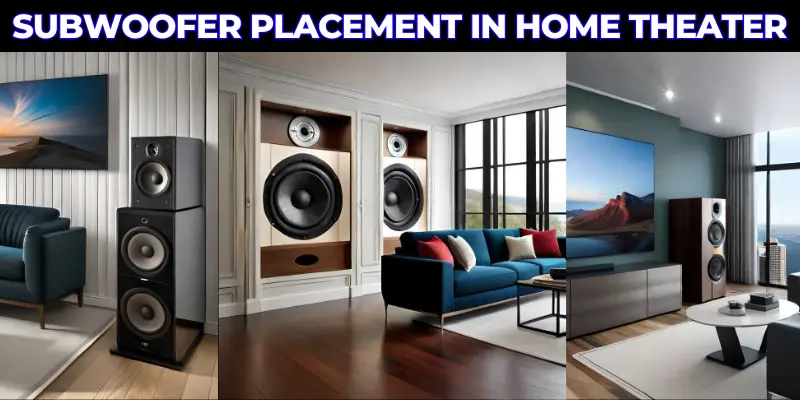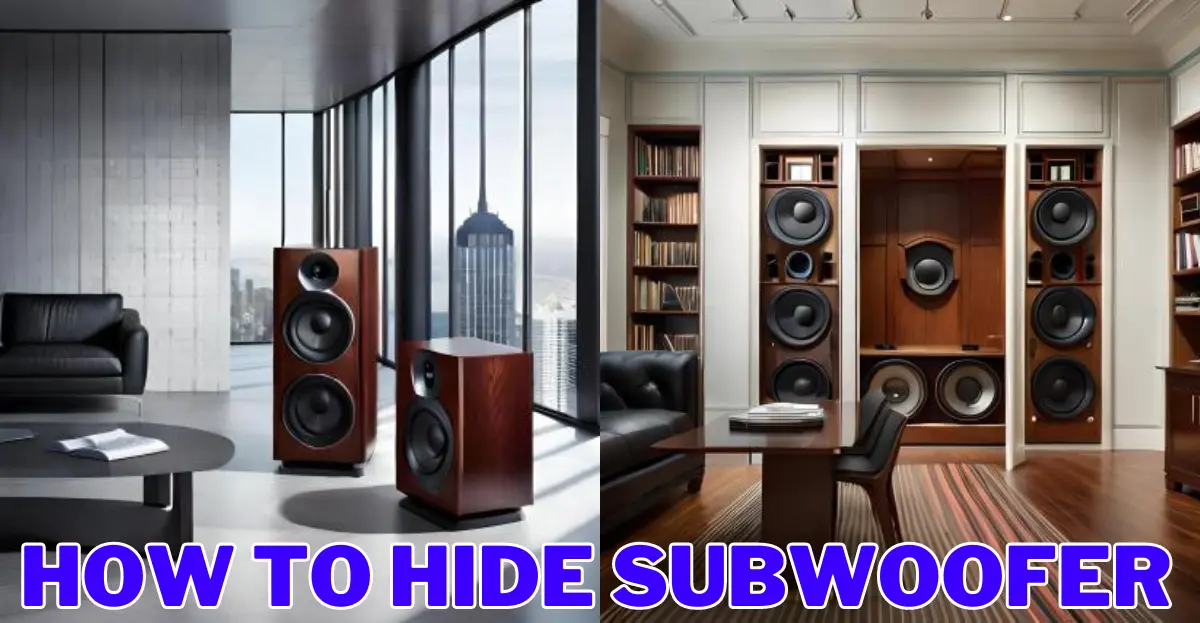
Are you tired of lackluster audio experiences that leave your apartment devoid of that cinematic impact? Imagine a world where the rumbling bass and immersive depth of sound are missing from your favorite movies, music, and games.
Without a subwoofer in your apartment, your audio landscape remains flat, robbing you of the spine-tingling excitement only deep bass can provide. But fret not! The solution lies in embracing a subwoofer, injecting life into your living space with its profound low-frequency prowess.
Trust me to guide you through the journey of transforming your apartment into a haven of rich, resonant audio that will elevate your senses and redefine your entertainment.
Now, let me give you the exact answer to your question: can you use a subwoofer in an apartment?
Yes, you can use a subwoofer in an apartment, but being mindful of your neighbors is essential. You can reduce the amount of bass that travels through the walls and floors by placing the subwoofer in the corner of the room, using isolation pads, and turning down the volume.
You should also avoid playing your subwoofer too loudly or for extended periods.
If you are a guy who is always in a hurry, then the answer I have already given you is enough, but if you want to know the benefits, drawbacks, the right subwoofer, and best placement for you in your apartment.
Do you have question that are subwoofers worth it. Don’t worry I have upload a article on it. you can read that article to understanding the worth of subwoofer.
Key Takeaways
- Subwoofers elevate apartment audio, but balance is key: Enjoy bass while respecting neighbors.
- Volume control matters: Maintain reasonable levels to prevent disturbing others.
- Time management: Limit prolonged, loud subwoofer usage to avoid neighbor conflicts.
- Choose the right subwoofer: Consider apartment size, music preferences, and budget.
- Strategic placement is vital: Corners and isolation pads reduce neighbor noise.
- Subwoofers provide immersive audio, improved sound, and increased enjoyment.
- Alternative options: Soundbars, wireless modules, and acoustic panels suit apartments.
- FAQs clarify subwoofer usage without causing disruptions.
- Care tips: Place subwoofers thoughtfully, clean regularly, and consider noise limiters.
- Prioritize harmony: Balanced sound and respectful use enrich apartment living.
- Key Takeaways
- Can you use a Subwoofer in an Apartment?
- What are the benefits of using the subwoofer in the apartment?
- What are the drawbacks of using a subwoofer in the apartment?
- What size subwoofer is needed for my apartment?
- How to pick the right subwoofer for your apartment?
- Best Placement in Apartments for Subwoofers:
- How to set up a subwoofer in the apartment?
- How to take care of your subwoofer in the apartment?
- Alternatives to Subwoofers for Apartment Living
- FAQs
- Conclusion
Can you use a Subwoofer in an Apartment?
Subwoofers can be a game-changer when creating an immersive audio environment in your apartment. These powerful devices offer a depth of sound that elevates your entertainment to a new level. But the burning question remains: can you use a subwoofer in an apartment without disturbing your neighbors and compromising your living space?
The short answer is yes; you can use a subwoofer in your apartment. The key, however, is balancing enjoying your audio to the fullest and being considerate of those around you. Let’s delve into some essential insights and tips for incorporating a subwoofer into your apartment setup:
1. Mindful Placement for Optimal Acoustics
Positioning your subwoofer strategically within your apartment can make a world of difference. Placing it in the corner of the room can help distribute the bass evenly, preventing it from concentrating in one area and minimizing potential disturbances for neighbors.
2. Isolation Pads for Vibration Control
Subwoofers can generate significant vibrations, which, in close quarters, might cause disruptions. By placing your subwoofer on isolation pads, you effectively minimize the transmission of vibrations through walls and floors, enhancing the acoustic experience within your apartment.
3. Volume Moderation: Finding the Sweet Spot
While it’s tempting to crank up the volume to feel those heart-pounding beats, it’s crucial to exercise restraint. Keeping the volume at a reasonable level ensures you enjoy the bass while preventing excessive noise that could disturb neighboring units.
4. Time Management: Avoid Prolonged Usage
Long listening sessions with thumping bass might be your ideal audio haven, but extended periods of loud subwoofer activity can lead to neighborly disputes. Be considerate and limit the duration of high-intensity audio sessions, especially during late hours.
5. The Right Subwoofer Choice
Selecting the appropriate subwoofer for your apartment setup is essential. Opt for a subwoofer with adjustable settings, including volume and frequency controls. This allows you to fine-tune the output to suit your space without overwhelming it.
6. Harmonizing Aesthetics and Acoustics
Integrating your subwoofer seamlessly into your apartment’s décor can be an art. Choose a subwoofer design that complements your interior while considering its acoustic impact on the space.
7. Alternatives to Consider
If you’re concerned about subwoofer-related challenges, there are alternatives worth exploring. Soundbars with built-in subwoofers and high-quality headphones can deliver impressive audio without needing a standalone subwoofer.
Many people have a question about can I put things on top of the subwoofer. If you worry about this question then don’t worry I have upload a article on this topic. You can read that article by visiting my this site
What are the benefits of using the subwoofer in the apartment?

First, let’s know the benefits of using the subwoofer in your apartment. There are so many benefits of using the subwoofer in an apartment, but I’m going to share with you some that are very special.
Subwoofers can offer several benefits for apartment dwellers, including:
- Immersive audio experience: Subwoofers can add a deep, rumbling bass to your audio system that can make movies, music, and games feel more immersive. This is especially important in apartments, where the walls and ceilings can dampen the speakers’ sound.
- Improved sound quality: Subwoofers can help improve your audio system’s overall sound quality by providing a more balanced frequency response. This means you’ll hear more detail in the music, and the soundstage will be more spacious.
- Reduced neighbor noise: By placing the subwoofer in the corner of the room and using isolation pads, you can help to reduce the amount of bass that travels through the walls and floors. This can help to prevent noise complaints from your neighbors.
- Increased enjoyment: Subwoofers can make your audio experience more enjoyable. Whether watching a movie, listening to music, or playing games, a subwoofer can add excitement and immersion that you won’t get with just a pair of speakers.
A subwoofer is an excellent option to improve your audio experience in your apartment. Just be sure to choose the right subwoofer for your space and use it responsibly to avoid disturbing your neighbors.
What are the drawbacks of using a subwoofer in the apartment?

You know, if something has benefits, it will have some drawbacks. That’s why, now, let’s understand the drawbacks of using the subwoofer in an apartment. Below are some of them:
- Noise complaints from neighbors: If you don’t use your subwoofer responsibly, you could get noise complaints from your neighbors. This could lead to fines or even eviction.
- Damage to your apartment: If you turn your subwoofer up too loud, it could damage your walls, floors, or ceiling.
- Expensive: Subwoofers can be expensive, especially if you want a high-quality one.
- Requires space: Subwoofers can be large and bulky, so you may not have enough space for one in your apartment.
- Not always necessary: If you’re not a big bass fan, you may not need a subwoofer in your apartment.
If you’re considering getting a subwoofer for your apartment, carefully weigh the benefits and drawbacks. If you can use it responsibly and avoid disturbing your neighbors, then a subwoofer can be a great addition to your audio system. However, it’s best to avoid it if you’re unsure if you can use it responsibly.
What size subwoofer is needed for my apartment?
The size of the subwoofer you need for your apartment will depend on a few factors, including the size of your apartment, the type of music you listen to, and your preferences.
Size of your apartment:
If you have a small apartment, you’ll need a smaller subwoofer. A smaller subwoofer will produce less bass, but it will also be less likely to disturb your neighbors. You can get away with a larger subwoofer if you have a larger apartment. A larger subwoofer will produce more bass, which can be great for movies and music with a lot of low-frequency content.
Type of music you listen to:
If you listen to a lot of music with a lot of bass, you’ll need a subwoofer to produce a lot of bass. For example, if you listen to hip-hop, electronic, or rock music, you’ll need a subwoofer to produce deep, rumbling bass. If you hear a lot of classical music or jazz, you may not need a subwoofer that produces as much bass.
Personal preferences:
Ultimately, the size of the subwoofer you need is up to your personal preferences. Some people prefer a subwoofer with a lot of bass, while others choose a more subtle subwoofer.
Here are some general recommendations for subwoofer size based on the size of your apartment:
- Small apartment (under 500 square feet): A 10-inch subwoofer is a good option for a small apartment. This size subwoofer will produce enough bass to fill the room without being too overwhelming.
- Medium apartment (500-1000 square feet): A 12-inch subwoofer is a good option for a medium-sized apartment. This size subwoofer will produce more bass than a 10-inch subwoofer, better suited for apartments with higher ceilings.
- Large apartment (over 1000 square feet): A 15-inch subwoofer is a good option for a large apartment. This size subwoofer will produce the most bass and be ideal for apartments with high ceilings and open floor plans.
It’s important to note that these are just general recommendations. The best way to determine the correct size subwoofer for your apartment is to experiment with different sizes and see what sounds best.
Many people think that if we brought the subwoofer at home and run it, then might be subwoofer break our glass. Yes, in many cases subwoofers break the glass but don’t worry I have upload a article on it.
Read More: Can a Subwoofer break Glass
How to pick the right subwoofer for your apartment?

Subwoofers are a great way to add deep, rumbling bass to your audio system. However, choosing the right subwoofer for your apartment can be tricky. You need to consider the size of your apartment, the type of music you listen to, and your budget.
In this article section, we will discuss how to pick the right subwoofer for your apartment. We will cover the following topics:
- Size of subwoofer
- Type of music
- Budget
- Other factors to consider
Size of subwoofer
The size of the subwoofer you need will depend on the size of your apartment. If you have a small apartment, you’ll need a smaller subwoofer. A smaller subwoofer will produce less bass, but it will also be less likely to disturb your neighbors.
You can get away with a larger subwoofer if you have a larger apartment. A larger subwoofer will produce more bass, which can be great for movies and music with a lot of low-frequency content.
Type of music
The type of music you listen to will also affect the size of the subwoofer you need. If you hear a lot of music with a lot of bass, such as hip-hop, electronic music, or rock music, you’ll need a subwoofer to produce a lot of bass.
If you listen to a lot of classical music or jazz, you may not need a subwoofer that produces as much bass.
Budget
Subwoofers can range in price from a few hundred dollars to several thousand dollars. Setting a budget before shopping is essential so you don’t overspend.
Other factors to consider
In addition to the size, type of music, and budget, you should consider a few other factors when choosing a subwoofer for your apartment. These include:
- Power output: The power output of a subwoofer is measured in watts. The higher the power output, the louder the subwoofer will be. If you plan on listening to your subwoofer at high volumes, you’ll need a subwoofer with a high power output.
- Frequency response: The frequency response of a subwoofer is the range of frequencies it can produce. A broader frequency response means the subwoofer can produce a more comprehensive range of sounds. This is important if you want your subwoofer to sound good with various music.
- Features: Some subwoofers have additional features, such as built-in amplifiers or wireless connectivity. These features can be nice to have, but they can also add to the cost of the subwoofer.
Read More: Best subwoofers under 500
Best Placement in Apartments for Subwoofers:

Subwoofers are a great way to add deep, rumbling bass to your audio system. However, placing a subwoofer in an apartment can be tricky. You need to find a location that will produce the best sound without disturbing your neighbors.
We will cover the following topics:
- Corner placement
- Wall placement
- Center placement
- Experimentation
Corner placement
Corner placement is the most common and recommended placement for subwoofers in apartments. This is because corners are natural bass traps, which means they help to absorb the low frequencies produced by the subwoofer. This helps to prevent the bass from becoming too overwhelming and disturbing your neighbors.
Wall placement
Wall placement can also be a good option for subwoofers in apartments. This is because walls can help reflect the bass sound waves, creating a more immersive listening experience. However, it’s essential to avoid placing the subwoofer too close to the wall, which can cause the bass to become too loud and distorted.
Center placement
Center placement is not the ideal placement for subwoofers in apartments. Center placement does not take advantage of the natural bass traps in corners or walls. As a result, the bass may not be as evenly distributed throughout the room, and it may be more likely to disturb your neighbors.
Experimentation
The best way to find the best placement for your subwoofer in your apartment is to experiment with different locations. Try placing it in different corners, on other walls, and in different room parts. See what sounds best to you and what doesn’t disturb your neighbors.
How to set up a subwoofer in the apartment?

So, you’ve decided to bring a subwoofer’s thumping bass and immersive audio experience into your apartment. Congratulations on your endeavor to elevate your audio setup! To balance powerful sound and considerate living, follow these steps for a seamless subwoofer setup.
- Choosing the Right Location
- Isolation and Vibration Control
- Subwoofer Placement Techniques
- Room Acoustics Consideration
- Calibration and Sound Adjustments
- Neighbor-Friendly Listening
Choosing the Right Location
Selecting the ideal spot for your subwoofer is the first step towards achieving exceptional audio quality without causing disturbances. Consider these factors:
- Corner Placement: Placing your subwoofer in the corner of the room can help distribute bass frequencies evenly, preventing overpowering bass concentration in a single area.
- Away from Walls: While corners are beneficial, ensure your subwoofer is not too close to walls to prevent excessive vibrations.
Isolation and Vibration Control
Subwoofers are notorious for producing vibrations that can travel through walls and floors, disrupting neighbors. Implement these strategies for vibration control:
- Isolation Pads: Place isolation pads beneath the subwoofer to absorb vibrations and prevent them from transmitting to surrounding surfaces.
- Rubber Feet: If your subwoofer doesn’t come with isolation pads, consider adding rubber feet to minimize contact between the subwoofer and the surface it’s placed on.
Subwoofer Placement Techniques
Strategic placement techniques can significantly impact your subwoofer’s performance and how it interacts with your apartment space:
- Front-Firing vs. Down-Firing: Different subwoofers have varying orientations. Front-firing subwoofers emit sound directly, while down-firing models bounce sound off the floor. Experiment with both to find the best fit for your space.
- Boundary Interference: Placing a subwoofer too close to a wall or corner can result in boundary interference, causing specific frequencies to resonate excessively. Adjust positioning to mitigate this effect.
Room Acoustics Consideration
Your apartment’s layout and furnishings play a role in how sound travels. Optimize your room’s acoustics:
- Furniture Arrangement: Arrange furniture to break up sound reflections and prevent audio waves from bouncing off large, flat surfaces.
- Acoustic Panels: Consider using acoustic panels to absorb sound reflections, creating a more controlled audio environment.
Calibration and Sound Adjustments
Calibrating your subwoofer ensures it complements your speakers and room acoustics:
- Crossover Settings: Adjust the crossover frequency to blend the subwoofer’s output seamlessly with your main speakers.
- Volume Levels: Set the subwoofer’s volume to enhance your audio experience without overpowering other frequencies.
Neighbor-Friendly Listening
Being a considerate neighbor is vital when enjoying powerful audio in an apartment:
- Time Management: Limit late-night or prolonged subwoofer use to avoid disturbances during quiet hours.
- Volume Control: Keep the volume enjoyable while not causing disturbances for others.
Setting up a subwoofer in your apartment requires careful planning and consideration. By strategically placing the subwoofer, controlling vibrations, optimizing acoustics, and fine-tuning settings, you can enjoy an immersive audio experience while maintaining harmony with your neighbors and surroundings.
Read More: How to Hide Subwoofer
How to take care of your subwoofer in the apartment?
Taking care of your subwoofer is essential if you use it in an apartment. Below are some of the best tips to take care of your subwoofer.
- Place your subwoofer in a corner of the room. This will help to distribute the bass evenly and prevent it from concentrating in one area, which could disturb your neighbors.
- Use isolation pads under your subwoofer. This will help to reduce the vibration caused by the subwoofer, which could also disturb your neighbors.
- Don’t play your subwoofer too loud. This is the most important tip! If you play your subwoofer too loud, it will disturb your neighbors.
- Avoid placing your subwoofer for extended periods. Even if you’re not playing your subwoofer at a loud volume, extended periods of use can still be disruptive to your neighbors.
- Keep your subwoofer clean. Dust and debris can build up on the subwoofer and cause it to overheat. You can use a vacuum cleaner with a soft brush attachment to clean the exterior of the subwoofer. If the subwoofer has a grill, you can remove it and clean it with a damp cloth.
- Have your subwoofer serviced regularly. A qualified technician can inspect your subwoofer and ensure it is working well. This will help to prevent any problems from occurring down the road.
I hope these tips help you take care of your subwoofer and enjoy it for many years!
Here is an additional suggestion:
If you are concerned about disturbing your neighbors, you may want to consider investing in a subwoofer with a built-in noise limiter. This will automatically reduce the subwoofer’s volume if it reaches a certain level, which can help prevent noise complaints.
Read More: Do subwoofer need a box
Alternatives to Subwoofers for Apartment Living

When apartment living calls for a rich audio experience without compromising space and neighborly harmony, considering alternatives to traditional subwoofers becomes essential. Let’s explore innovative options that deliver impressive sound without the booming bass.
- Soundbars with Built-in Subwoofers
- Wireless Subwoofer Modules
- High-Quality Headphones
- Acoustic Panels and Bass Traps
- Portable Bluetooth Speakers
- In-Wall or In-Ceiling Speakers
Soundbars with Built-in Subwoofers
Soundbars are a sleek and space-efficient alternative often equipped with integrated subwoofers. They provide a convenient solution to enhancing audio quality while minimizing the need for additional equipment.
- Immersive Sound: Soundbars offer improved audio compared to TV speakers, with built-in subwoofers ensuring balanced bass delivery.
- Space-Saving Design: Perfect for apartments, soundbars reduce clutter while delivering a more cinematic audio experience.
Wireless Subwoofer Modules
Wireless subwoofer modules are an excellent choice for those seeking enhanced bass without a full-sized subwoofer. These compact devices are designed to complement existing audio setups seamlessly.
- Easy Integration: Wireless subwoofer modules can be paired with your existing sound system, adding depth to audio without taking up substantial space.
- Flexibility: Place the module strategically to minimize vibration transmission while still enjoying impactful bass.
High-Quality Headphones
When private audio enjoyment takes precedence, high-quality headphones step into the spotlight. They provide an immersive listening experience without disturbing neighbors.
- Precise Audio: Premium headphones deliver accurate sound representation, allowing you to experience music and movies as intended.
- Personal Entertainment: Ideal for late-night movie marathons or immersive gaming sessions without affecting others.
Acoustic Panels and Bass Traps
Enhancing audio within your apartment doesn’t always involve new devices. Acoustic panels and bass traps are accessories that optimize sound quality without introducing additional noise.
- Sound Reflection Control: Acoustic panels minimize sound reflections, improving audio clarity in your living space.
- Bass Management: Bass traps absorb excessive low frequencies, maintaining a balanced audio environment.
Portable Bluetooth Speakers
For versatile audio enjoyment, portable Bluetooth speakers offer a practical solution that can be used throughout your apartment.
- On-the-Go Audio: Carry the speaker to different areas of your apartment, ensuring consistent sound quality.
- Wireless Convenience: Bluetooth connectivity eliminates the need for cumbersome cables while maintaining audio quality.
In-Wall or In-Ceiling Speakers
Maximize space while achieving a well-distributed audio experience by opting for in-wall or in-ceiling speakers.
- Space Optimization: These discreet speakers blend seamlessly with your apartment’s aesthetics, saving valuable floor space.
- Balanced Sound: Proper placement ensures even sound distribution, enhancing your apartment’s audio ambiance.
When the rumbling bass of a traditional subwoofer doesn’t align with your apartment living goals, these alternatives step in as innovative solutions.
From built-in subwoofers within soundbars to portable Bluetooth speakers and acoustic enhancements, these options cater to diverse preferences while maintaining harmony with your surroundings.
FAQs
Conclusion
In pursuing a captivating audio experience within the confines of an apartment, the question of using a subwoofer emerges as a focal point. The journey through this article has illuminated the possibilities, alternatives, and strategies to achieve the perfect harmony between immersive sound and neighborly consideration.
The absence of rumbling bass need not be the norm in apartment living. By embracing careful subwoofer placement, utilizing isolation techniques, and being mindful of volume, one can savor the deep auditory thrills without disrupting neighbors’ peace.
It’s a symphony of balance, where the pulsating beats and resonant melodies enrich personal entertainment while upholding communal harmony.
Beyond traditional subwoofers, innovative alternatives like soundbars with built-in subwoofers, wireless modules, and high-quality headphones offer an array of choices for enhancing audio without compromising space or serenity.
The seamless integration of these alternatives seamlessly into apartment aesthetics showcases the compatibility of modern technology with contemporary living.
With meticulous planning, selecting the right subwoofer size, type of music consideration, and budget awareness culminates in a personalized audio setup. This setup transforms an apartment into an acoustic haven where the sound envelops without overwhelming, catering to individual preferences and enriching musical experiences.
In essence, the journey of setting up a subwoofer in an apartment is a testament to the fusion of technology and empathy. It’s about reveling in the richness of sound while respecting the tranquility of shared living spaces.
One can navigate this harmonious path toward audio excellence in apartment living by embracing strategic placement, technological innovation, and an understanding of audio nuances.
Read More Our Articles:
Images credit by Canva







